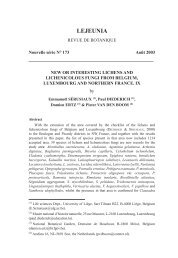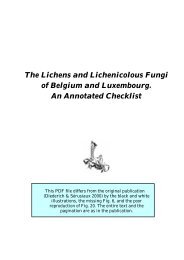A Synopsis of the Genera Skyttea, Llimoniella and - Lichens of ...
A Synopsis of the Genera Skyttea, Llimoniella and - Lichens of ...
A Synopsis of the Genera Skyttea, Llimoniella and - Lichens of ...
Create successful ePaper yourself
Turn your PDF publications into a flip-book with our unique Google optimized e-Paper software.
448 THE LICHENOLOGIST Vol. 32<br />
J<br />
FIG. 6. <strong>Skyttea</strong> tavaresae (Tavares 1419). A, ascoma on Pyrrhospora thallus; B, excipular hairs.<br />
Scales: A=100|im; B = 5nm.<br />
but just below <strong>the</strong> subhymenium reddish brown, K+ pale purplish or violet,<br />
N - , 15-20 um thick; excipular hairs dark greyish brown, K+ bright aeruginose<br />
green, N+ dark reddish brown, straight, wall apically not thickened,<br />
with irregular, pigmented ring-like structures (see Fig. 6), c. 30-48 x 2-5-<br />
3 um. Subhymenium hyaline to yellowish, c. 10 um thick. Hymenium 30-60 urn<br />
thick. Epihymenium hyaline. Paraphyses filiform, simple, septate, 1-5 um thick,<br />
apically slightly thicker. Asci subcylindrical, wall apically thicker, 8-spored,<br />
c. 43-50 x 5-8 um. Ascospores hyaline, elongate ellipsoid, O(-l)-septate,<br />
biguttulate, (8-)9-12(-13) x 2-5-3 um.<br />
Host. On <strong>the</strong> thallus <strong>of</strong> Pyrrhospora cf. quernea.<br />
Distribution. Known from two localities in <strong>the</strong> USA (California).<br />
Observations. This species is mainly characterized by <strong>the</strong> unusual dark<br />
greyish brown exciple, which is K+ bright aeruginose green <strong>and</strong> N+ dark<br />
reddish brown (basally with an additional, reddish brown, K+ purplish or<br />
violet pigment), by <strong>the</strong> long concolorous excipular hairs (hairs are pale<br />
greenish or hyaline in most o<strong>the</strong>r <strong>Skyttea</strong> species) <strong>and</strong> <strong>the</strong> long, but narrow,<br />
biguttulate ascospores. The differences with S. carboneae <strong>and</strong> 5. nitschkei are<br />
given in <strong>the</strong> identification key. The species is named after I. I. Tavares who<br />
collected <strong>the</strong> first specimen <strong>of</strong> this species <strong>and</strong> who made it available for study.<br />
We studied a specimen <strong>of</strong> a similar, but distinct species, growing on<br />
Pertusaria cf. santamonicae [USA, California, Santa Barbara Co., Santa Rosa<br />
Isl<strong>and</strong>, pass along <strong>the</strong> main road just SE <strong>of</strong> Black Mountain, 33°58'45"N,<br />
120°4'30"W, i 1994, T. H. Nash III 32.615 (ASU)]. The ascospores are<br />
8-5-10-5(-ll-5) x 3-3-5 um, <strong>the</strong> ascomata 150-250(-300) um in diam., <strong>the</strong><br />
hairs reach at least 50 um <strong>and</strong> <strong>the</strong> exciple contains <strong>the</strong> dark red, K+<br />
B





